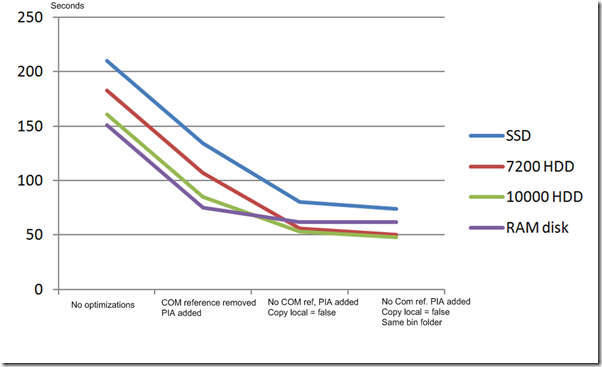The default TFS build label does not have a xx.xx.xx.xx pattern, but looks like “MyBuild_20070418.1”. So we cant assign the value to the AssemblyVersion or AssemblyFileVersion attribute, however the AssemblyInformationalVersion attribute can be used as it is a string.
1: <Target Name="AfterGet">
2: <!-- Insert build label into assemblies -->
3: <Message Text="Modifying AssemblyInfo files under "$(SolutionRoot)"." />
4:
5: <Message Text="Undo checkout assemblyinfo files, make sure no files are checked out." />
6: <Exec Command=""C:\Program Files\Microsoft Visual Studio 9.0\Common7\IDE\tf.exe" undo *.* /recursive /noprompt"
7: WorkingDirectory="$(MSBuildProjectDirectory)\..\sources" ContinueOnError="true"/>
8:
9: <Message Text="Checkout assemblyinfo files" />
10: <Exec Command=""C:\Program Files\Microsoft Visual Studio 9.0\Common7\IDE\tf.exe" checkout "AssemblyInfo.*" -r"
11: WorkingDirectory="$(MSBuildProjectDirectory)\..\sources" ContinueOnError="true"/>
12:
13: <ItemGroup>
14: <AssemblyInfoFilesCs Include="$(SolutionRoot)\**\assemblyinfo.cs" />
15: </ItemGroup>
16:
17: <Message Text="Adding $(LabelName) to %(AssemblyInfoFilesCs.fullpath)" />
18:
19: <WriteLinesToFile
20: File="%(AssemblyInfoFilesCs.fullpath)"
21: Lines="[assembly: AssemblyInformationalVersion("$(LabelName)")]"
22: Overwrite="false"/>
23: </Target>
24:
25:
26:
27: <Target Name="AfterCompileSolution">
28: <Message Text="Undo checkout assemblyinfo files" />
29:
30: <Exec Command=""C:\Program Files\Microsoft Visual Studio 9.0\Common7\IDE\tf.exe" undo *.* /recursive /noprompt"
31: WorkingDirectory="$(MSBuildProjectDirectory)\..\sources" ContinueOnError="false"/>
32: </Target>
With this in place all assemblies (dll, exe), will have a AssemblyInformationalVersion attribute with the label of the TFS Build. So it should be a no-brainer to trace a dll to a point in time in TFS Source Control. Just open the dll in reflector and disassemble the dll.
An alternative to AssemblyInformationalVersion would be AssemblyConfiguration, but then we have to use a task that can do a text replace, as it is usually already defined in AssemblyInfo.cs files.













